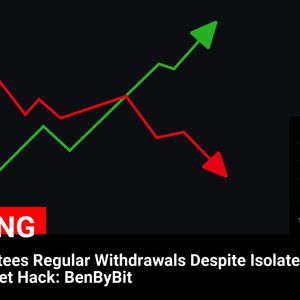Buckle up, crypto enthusiasts and Forex traders! All eyes are on the Reserve Bank of Australia (RBA) as they gear up to announce their first monetary policy decision of 2025. The buzz in the financial markets is palpable: a RBA interest rate cut is widely expected. But what does this mean for the Australian Dollar (AUD/USD) and the broader market sentiment that often ripples into the crypto sphere? Let’s dive into the details of this pivotal economic event. Is an RBA Interest Rate Cut Inevitable? Decoding the Signals For months, the RBA has held its Official Cash Rate (OCR) steady at 4.35%, battling stubbornly high inflation. However, recent economic indicators suggest a shift in strategy. Here’s the breakdown: Easing Inflation: Australian core inflation has shown signs of moderating. The Trimmed Mean CPI, the RBA’s preferred gauge, came in lower than expected in the last quarter of 2024. This is a key factor fueling expectations for a rate cut. Economic Slowdown Concerns: Persistent high interest rates are squeezing households and businesses, leading to concerns about sluggish economic growth. Policymakers are under pressure to stimulate the economy. Global Economic Uncertainty: Factors like potential US tariffs and global economic headwinds add complexity to the RBA’s decision-making process. While inflation remains above the RBA’s target range, the slight moderation has opened the door for a potential RBA interest rate cut . The question is, will it be a single cut or the start of a series of easing measures? Australia Inflation: The Decisive Factor The state of Australia inflation is the linchpin of the RBA’s decision. Let’s examine the latest inflation data: Consumer Price Index (CPI) – Q4 2024 Highlights: Indicator Q4 2024 Previous RBA Target Trimmed Mean CPI (Quarterly) 0.5% – – Trimmed Mean CPI (Annualized) 3.2% 3.5% 2-3% As you can see, while inflation remains above the 2-3% target, the downward trend is encouraging for those anticipating a rate cut. The deceleration in annualized inflation from 3.5% to 3.2% is a significant signal. However, it’s not all smooth sailing. Robust employment figures complicate the picture. Strong employment growth can be inflationary, potentially dampening the RBA’s appetite for aggressive rate cuts. The January employment data, due after the RBA announcement, will be crucial in shaping future policy expectations. Monetary Policy Outlook: Cautious Easing Expected Market consensus leans towards a 25 basis points (bps) RBA interest rate cut . However, analysts don’t foresee a rapid-fire series of cuts. The RBA is expected to adopt a cautious approach to monetary policy easing. Key Expectations for RBA’s Monetary Policy: Gradual Rate Cuts: The RBA is likely to unwind restrictive policy settings at a slow pace, prioritizing a measured approach. Data-Dependent Decisions: Future rate adjustments will heavily rely on incoming economic data, particularly inflation and employment figures. Balancing Inflation and Growth: The RBA aims to strike a delicate balance between controlling inflation and supporting economic growth, navigating a complex economic landscape. Governor Michele Bullock’s press conference following the announcement will be closely scrutinized for clues about the RBA’s future policy path. Any hints of a more dovish or hawkish stance will trigger market reactions. AUD/USD in Focus: How Will the Rate Cut Impact the Aussie Dollar? The AUD/USD pair is poised for potential volatility following the RBA announcement. Here’s how different scenarios could play out: Expected 25 bps Cut: An anticipated 25 bps cut might exert some selling pressure on the Australian Dollar (AUD). However, the extent of the weakness will depend on the RBA’s forward guidance. Unexpected 50 bps Cut or Dovish Signals: A larger-than-expected 50 bps cut or indications of further aggressive easing would be significantly bearish for the AUD, potentially leading to a sharp decline in AUD/USD . Hawkish Cut Scenario: Conversely, if the RBA signals spaced-out, gradual cuts, it could be interpreted as a “hawkish cut,” potentially supporting the AUD. Valeria Bednarik, Chief Analyst at Bitcoin World, notes the technical setup for AUD/USD : “The AUD/USD pair peaked at 0.6373 ahead of the announcement, its highest since mid-December. The pair maintains its technically bullish stance amid broad US Dollar (USD) weakness. Uncertainty over US tariffs and their impact on the Australian economy will also be a factor in the RBA’s considerations. Technically, AUD/USD has scope to advance towards the 0.6470 region if it overcomes immediate resistance at 0.6373 and interim resistance at 0.6430. A dovish outcome could trigger a slide below 0.6300, potentially extending to the 0.6230 zone.” Understanding Central Banks: Key Concepts To better grasp the significance of the RBA’s decision, let’s recap some fundamental concepts about central banks: Central Bank Mandate: Price Stability: Central banks are primarily tasked with maintaining price stability, managing inflation and deflation to ensure a healthy economy. Policy Rate Tool: They use the benchmark policy rate (interest rate) to influence economic activity, adjusting it to control inflation and stimulate growth. Monetary Policy Actions: Monetary Tightening (Rate Hikes): Raising interest rates to combat inflation by making borrowing more expensive and slowing down economic activity. Monetary Easing (Rate Cuts): Lowering interest rates to stimulate economic growth by making borrowing cheaper and encouraging investment and spending. Decision-Making Bodies: Policy Boards: Independent bodies composed of experts who decide on monetary policy and interest rates. Hawks vs. Doves: Board members with differing views on monetary policy – hawks favor tighter policy to control inflation, while doves prefer looser policy to boost growth. Chairman/President: Leads the board, builds consensus, and often acts as the public face of the central bank. RBA Monetary Policy Statement: A Key Indicator The RBA Monetary Policy Statement, released after each meeting, is a crucial document. It explains the RBA’s policy decision and provides insights into their economic outlook. This statement can significantly impact the Australian Dollar (AUD) and create short-term trading opportunities. RBA Monetary Policy Statement Details: Release Schedule: Following each of the RBA’s eight annual meetings. Impact: High potential to influence AUD volatility and establish short-term trends. Interpretation: Hawkish statements are generally bullish for AUD, while dovish statements are bearish. Next Release: Tue Feb 18, 2025, 03:30 GMT. Stay Tuned for the RBA Decision The upcoming RBA announcement is a pivotal event for the Australian economy and the AUD/USD currency pair. Traders and investors should closely monitor the news and Governor Bullock’s press conference for insights into the future path of interest rates and the implications for the markets. Will the RBA interest rate cut be the powerful catalyst to reshape the economic landscape? Keep watching! To learn more about the latest Forex market trends, explore our article on key developments shaping interest rates and institutional adoption.



















